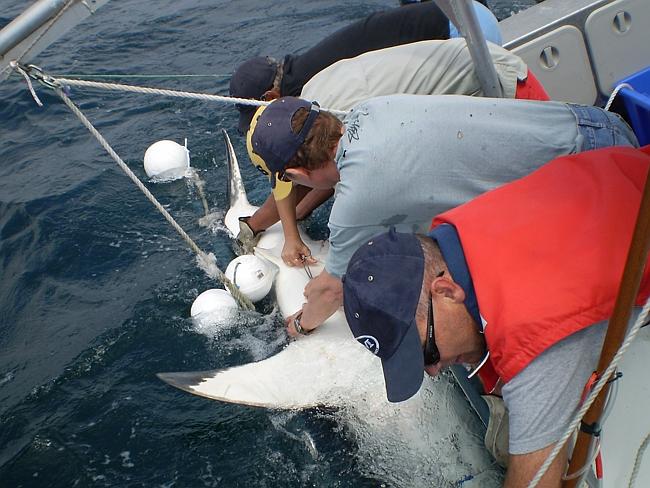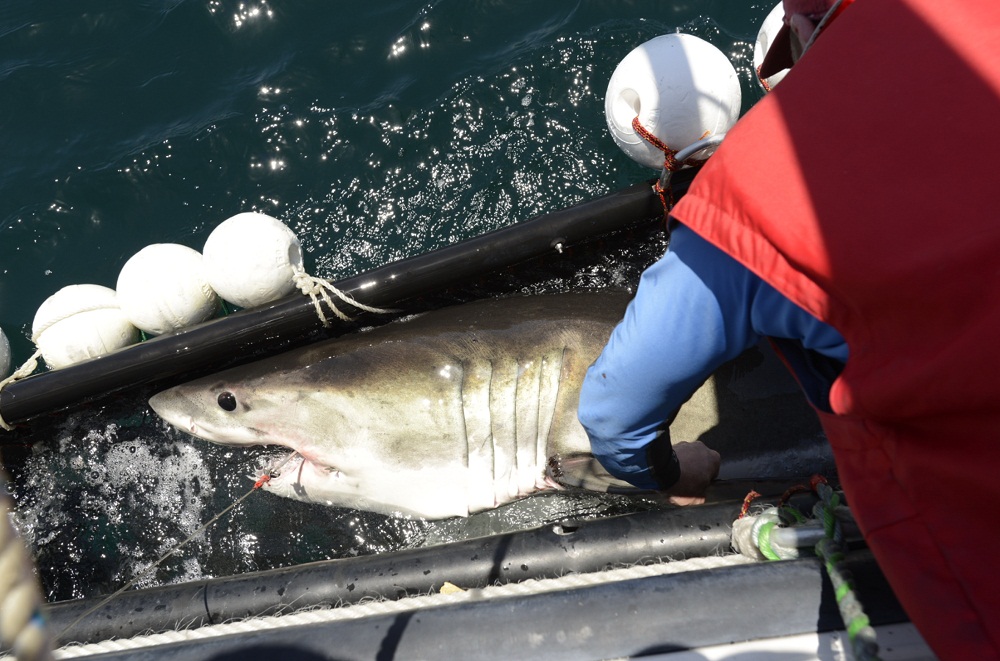
It's April 2011, summer is well and truly over and Betty*, a juvenile white shark, has just surfaced off the coast of New South Wales.
It is the first time the female ocean predator has come to the top of the ocean in several hours and the only break she has had in several days.
For almost a month this young but big fish has been making her way from the cool waters of the Bass Strait, some 800km behind her, to the warmer northern climes in search of food.
And boy is she hungry.
Luckily for Betty just a few kilometres ahead is Port Stephens where a smorgasbord of fish, rays and other sharks await her.
Betty spends the next few months dining out on this selection of marine life that frequent this stretch of coastline - one of only two known white shark nursery areas on the east coast - before she heads south.
For the next two weeks she hugs the coastline resurfacing every two to three days before arriving off the top end of the Victorian coast.
Her satellite tracking device, which was fitted at Christmas 2010, keeps transmitting her position every time she resurfaces from the ocean but then goes dead at the end of July 2011, recording 2400km in total.

It's another five months, at Christmas again, before Betty's tag begins transmitting once more.
Betty, still a juvenile and likely to be measuring at least 3.1m, pops up near Corner Inlet off the Victorian coast at the southern end of 90 Mile Beach - the other known white shark nursery area.
She spends at least a week in this popular feeding ground before beginning another journey.
But rather than head back down to the coastal waters of Tasmania as she did the previous year, Betty changes tack and begins a mammoth trek to the Great Barrier Reef.
And unlike the year before, Betty doesn't stop in any one place for great periods of time.
She basically swims continuously over the course of this journey along the coastlines of Victoria, NSW and Queensland, resurfacing multiple times along NSW but then submerging for days at a time until she reaches - what can only be assumed - was her intended destination, an area south of Swains Reef.

This pristine body of water 250km off the Queensland coast is rich with manta rays and sea snakes, as well as recreational fishing-sized tuna, coral trout and giant trevally, making it very popular with sharks.
By the time she makes her way back to the Victorian coastline she would have travelled a staggering 4500km in six months.
Details of this intriguing two-year journey, covering almost 7000km, were collected by a satellite tracking tag as part of our shark tagging program.
Information collected over the course of the almost two-decade long project has led scientists to believe that Betty will make this trek numerous times in her long life. But whether it will be the exact same journey, how long she will stay or why is still a mystery.
Australian scientists know white sharks follow food.
They know they can spend days, weeks, sometimes months in one area.
But predicting exactly when or how long they will stay - or what danger they pose to humans - is still unknown.
As arguably Australia's top shark expert, Barry Bruce knows more than most about these feared but fascinating creatures.
The scientist and his team have scoured our oceans in search of answers for nearly 20 years.
The team have uncovered a treasure trove of riveting behavioural patterns that hopefully will help us - and government policy makers - to understand these ocean predators.

We now know, thanks to this research and that of collaborators at the University of Queensland, that Australia has two distinct populations of white sharks, one which travels up and down the east coast and sometimes across to New Zealand, and another which travels from South Australia all the way up the West Australian coast.
Generally these two populations do not venture past their side of the Bass Strait.
This is supported by the data collected by one of the more well-known satellite-tagged white sharks, Columba, a 3.5m 10-year-old female, who was tagged in 2006.
Columba travelled an estimated 3600km from the Neptune Islands, off South Australia, and the site of Australia's largest seal colony, up to Exmouth in WA's north and back again in less than six months.
After being tagged, Columba, whose journey is revered among our shark scientists, swam west then travelled through the shelf waters across the Great Australian Bight to Cape Leeuwin, before turning north.
Data collected from her track shows she then travelled in waters of 500 to 1000m in depth, for much of her trip to Exmouth. She then remained some 100km off Exmouth until early October that year before returning to The Bight. Her tag stopped transmitting in November 2006.
Yet, Bruce says, there is still so much we don't know, and he believes further research is key to finding out more.
His team's most recent project - studying juvenile white sharks off the NSW coast - led to the discovery that young white sharks congregate off the coast of Port Stephens, about 200km north of Sydney, for several months of the year before heading to the Corner Inlet/Lakes Entrance area in Victoria.

His team uses both satellite and acoustic tags and collaborates with scientists in SA, WA and New Zealand.
So far, scientists have tagged more than 50 white sharks with satellite tags and almost 300 with acoustic tags throughout Australia.
Initially satellite tags gave scientists their first real glimpse of how far and fast sharks can travel in a day.
Bruce estimates a shark travels between three to five kilometres per hour and is capable of covering around 70 to 125km per day, 500 to 875km per week and 2200 to 3150km per month.
But satellite tags are expensive, have a very short battery life and rely on the shark to surface before a position can be recorded. Researchers have now switched to using acoustic tags because they can last up to ten years and use underwater receivers, which are deployed along our coastlines and are capable of recording much more data to collect the information.
--
Read more about our Wealth from Oceans white shark research, including the top 10 facts about these mysterious creatures.
Our current white shark research is funded by the Australian Government’s National Environmental Research Program’s Marine Biodiversity Hub.
*Betty is a name given to the shark for the purpose of this story. Her travels outlined in this article are speculative. We stopped naming sharks after Columba*
The above post is based on a longer article originally published by The Sunday Times. Read the original article.
